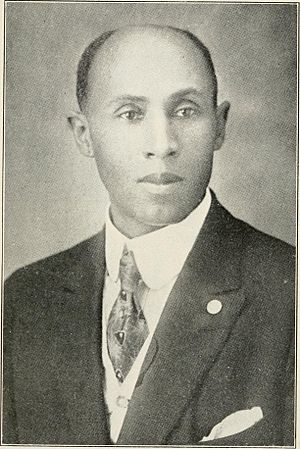Frederick Madison Roberts facts for kids
Quick facts for kids
Frederick Roberts
|
|
|---|---|
 |
|
| Member of the California Assembly | |
| In office January 6, 1919 – January 7, 1935 |
|
| Preceded by | Frank H. Mouser |
| Succeeded by | Augustus Hawkins |
| Constituency | 74th district (1919–1931) 62nd district (1931–1935) |
| Personal details | |
| Born | September 14, 1879 Chillicothe, Ohio, U.S. |
| Died | July 19, 1952 (aged 72) Los Angeles, California, U.S. |
| Resting place | Evergreen Cemetery, Los Angeles |
| Political party | Republican |
| Spouse |
Pearl Hinds
(m. 1921) |
| Children | Gloria Roberts Patricia Roberts |
| Education | University of Southern California Colorado College |
Frederick Madison Roberts (born September 14, 1879 – died July 19, 1952) was an important American leader. He owned and edited newspapers, worked as an educator, and ran his own businesses. He made history as the first known African American elected to the California State Assembly. He served there for 16 years and was called the "dean of the assembly." He is also known as the first African American elected to public office on the West Coast.
Frederick Roberts was also a great-grandson of Sally Hemings and President Thomas Jefferson.
Contents
Early Life and Education
Frederick Roberts was born in Chillicothe, Ohio, on September 14, 1879. His father, Andrew Jackson Roberts, went to Oberlin College. His mother, Ellen Wayles Hemings, was the daughter of Madison Hemings. Ellen was also the granddaughter of Sally Hemings and Thomas Jefferson.
When Frederick was six, his family moved to Los Angeles in 1885. His father started the first funeral home in the city owned by a Black person. Frederick had a younger brother, William Giles Roberts. Their family became very important in Los Angeles. They believed strongly in getting a college education and working to help the public.
Frederick Roberts went to Los Angeles High School. He was the first known African American to graduate from that school. He then started college at the University of Southern California (USC) to study law. He later graduated from Colorado College. He also studied at a special school to learn about funeral services.
Career and Community Work
In 1908, Roberts began editing a newspaper called the Colorado Springs Light. While living in Colorado, he also worked for El Paso County. He then moved to Mound Bayou, Mississippi, where he was the principal of the Mound Bayou Normal and Industrial Institute for several years. This was one of many schools created for African Americans in a time when schools were separated by race.
In 1912, Roberts returned to Los Angeles. He started his own newspaper, The New Age Dispatch, which was later called New Age. He edited this paper until 1948. He also joined his father in the funeral business, which they called A.J. Roberts & Son. Eventually, Frederick took over the business.
As a newspaper editor and business owner, Roberts became a key leader in the growing African American community in Los Angeles. Many African Americans were moving from the South to northern and western states during the Great Migration. Roberts was a member of a Methodist church. He also joined important groups like the National Association for the Advancement of Colored People (NAACP) and the Urban League. These groups worked for equal rights for Black people.
Family Life
In 1921, Frederick Roberts married Pearl Hinds. She had studied music at the Boston Conservatory of Music. They had two daughters, Gloria and Patricia. Gloria became a professional classical pianist. Patricia lived in Los Angeles.
Political Career
In 1918, Roberts was elected to the California State Assembly. He represented the 62nd District as a Republican. It was a very tough election, and his main opponent made unfair comments about his race.
While in office, Roberts worked on many important laws. He helped create the University of California at Los Angeles (UCLA). He also worked to make public education better. He suggested laws to protect civil rights and stop lynching, which was a terrible act of violence against Black people. In June 1922, he welcomed Black Nationalist leader Marcus Garvey to Los Angeles and rode in his parade.
Roberts was re-elected many times. He served for 16 years in total, earning the nickname "dean of the assembly." He was friends with Earl Warren, who later became the governor of California and then a very important judge in the United States.
In 1934, Roberts lost his re-election bid to Augustus Hawkins, a Democratic African American candidate. This happened during the Great Depression, after Franklin D. Roosevelt became president. After this defeat, Roberts ran for the United States House of Representatives twice but did not win. At that time, no African American had been elected to represent California in the United States Congress.
In the late 1930s and early 1940s, many more African Americans moved to Los Angeles. They came from the Southern United States to find jobs in growing industries. In 1946, Roberts ran for Congress again but lost to Helen Gahagan Douglas.
On July 18, 1952, Roberts was in a serious car accident near his Los Angeles home. He passed away the next day at Los Angeles County General Hospital. He was buried at Evergreen Cemetery. His wife and two daughters survived him.
Legacy and Honors
- In 1957, the city of Los Angeles named Frederick M. Roberts Park in his honor.
- On February 25, 2002, the California State Senate honored Frederick Madison Roberts. They voted unanimously for Senate Resolution 26 to recognize his important work and service to California.
- In February 2006, Mervyn Dymally of the California State Legislature shared Roberts' biography on his website. This was part of Black History Month, honoring early political leaders.

